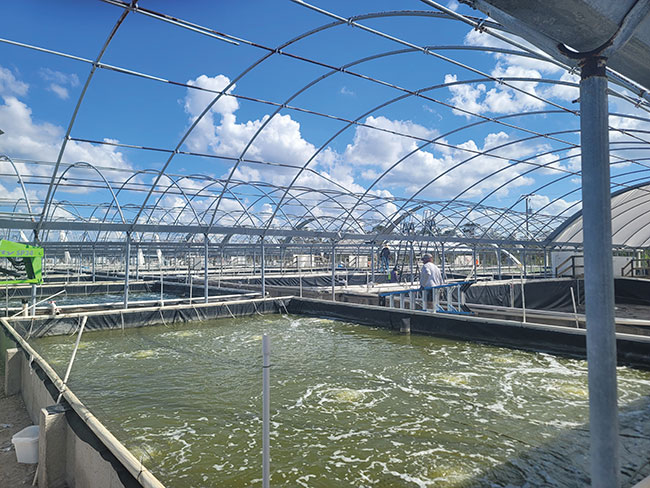
Sun Shrimp’s hurricane recovery
January 31, 2023
By Matt Jones
Florida farm’s resiliency could have lessons for other farms
 Photo: Robin Pearl
Photo: Robin Pearl Earlier this year, Hurricane Ian ravaged areas of South America, the Caribbean and the southern United States. Florida was hit particularly hard, where Ian was the deadliest hurricane to hit the state in almost 100 years. And while climate experts agree that we are likely to see more frequent, and more intense tropical storms in the coming years, hurricanes are a fact of life in Florida.
As such, there may be lessons that the wider aquaculture industry could learn from operations such as Sun Shrimp, the largest fresh shrimp farm in the country. While Sun Shrimp was rocked by Ian, owner Robin Pearl credits his company’s existing hurricane preparations with how quickly their recovery began.
“There’s always storms in Florida,” said Pearl. “When we built the farm, we knew that it’s not a matter of if, it’s only a matter of when we’re going to get hit. So, we have protocols in place to mitigate the effects of the hurricane. To be honest, I think we fared extremely well compared to the damage all around us – there’s a lot of communities that have been devastated and a lot of people have lost their lives and a lot of people got hurt. It’s a testament to our planning.”
Damage assessments and recovery
The road and bridge leading to Pine Island, where Sun Shrimp is located, had been completely washed away, so Pearl had to hitch a ride to the island on a boat and then hiked to the farm. In comparison to the scenes of devastation that he passed along his way, Pearl was surprised at how minimal the damage was on site.
A few tanks had some problems and some of the metal structure of the greenhouse was damaged – between material costs and labour, Pearl estimates the total cost of the damage at between $800,000 and $900,000. When Pearl spoke with Aquaculture North America in mid-November, he estimated that Sun Shrimp would be largely back to normal operations by the end of the month.
The shrimp themselves were largely safe, however, surviving the initial onslaught of the storm was only the first step. Pearl knew there was very little chance that road access to the farm would be restored in a timely fashion, but they only had enough propane on site to power the generators for three or four days.
“I made the executive decision at that point to turn off generators for our food shrimp to preserve propane so we could keep our more important stocks alive. We have a lot of genetics, we have a lot of broodstock – there’s a big broodstock season coming up. So, we decided to keep those going and by doing that we were able to keep the farm running off this emergency power for a good 10 to 12 days.”
And without any ice or enough employees on hand, there was no way of processing the food shrimp either. Pearl estimates they lost 40,000 or 50,000 lbs. of food shrimp, which were buried on site. But the more important stocks were saved.
Preperations
Ironically for an operation only three hours from Disney World, Pearl says one of Sun Shrimp’s keys when building farm infrastructure is “not to do Mickey Mouse stuff.” Every building on site was built rock solid with extra concrete columns and pillars and hurricane-rated glass on every door and window.
All the farm’s generators were installed on pedestals about three feet off the ground to avoid flooding impacts. And the shrimp on site are kept in special ‘gullwing’ tanks, prototypes the company designed which are intended to be hurricane proof. As for the greenhouse, the protocol is that the plastic roof is to be removed to avoid the wind catching it.
“It’s so much work to remove the roof and then to redeploy it, you really don’t want to do it unless you feel like this thing is really coming. Earlier in the week, it looked like we were going to get lucky and that the storm was going to go more to the panhandle. But during the weekend it started veering back further south so at that point we made the decision, ‘tomorrow morning, all hands-on deck.’ It was a big job, but that’s what helped save the structure. If we would have kept the plastic on there, that structure would have been destroyed.”
Looking towards the future, Pearl said that a lesson was learned about how easily they could lose access to the island. So, the company’s new protocol is to keep up to 20 extra propane tanks on hand in case they need to keep the generators running for a longer period. Staying in contact with employees was also a large challenge as cell phone systems were down, so Pearl is looking into long range radios for the future as well.
“All in all, I consider ourselves very lucky,” said Pearl. “There’s definitely a way of mitigating your exposure and your risk and your damages but it may cost a little bit extra.”





